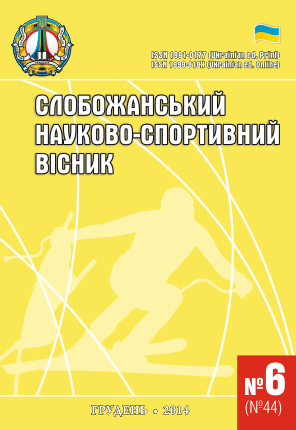Modeling attacking of high skills volleyball players
DOI:
https://doi.org/10.15391/snsv.2014-6.005Keywords:
technical and tactical actions, competitive activity, the model parameters, volume, efficiency, highly skilled volleyball playersAbstract
Purpose: to determine the model indicators of technical and tactical actions in the attack highly skilled volleyball players. Material and Methods: the study used statistical data of major international competitions: Olympic Games – 2012 World Championships – 2010, World League – 2010–2014 European Championship – 2010–2014. A total of 130 analyzed games. Methods were used: analysis and generalization of scientific and methodological literature, analysis of competitive activity highly skilled volleyball players, teacher observation, modeling technical and tactical actions in attacking highly skilled volleyball players. Results: it was found that the largest volume application of technical and tactical actions in the attack belongs to the group tactics «supple movement», whose indicator is 21,3%. The smallest amount of application belongs to the group tactics «flight level» model whose indicators is 5,4%, the efficiency of 3,4%, respectively. It is found that the power service in the jump from model parameters used in 51,6% of cases, the planning targets – 21,7% and 4,4% planning to reduce. Attacks performed with the back line, on model parameters used in the amount of 20,8% efficiency –13,7%. Conclusions: we prove that the performance of technical and tactical actions in the attack can be used as model in the control system of training and competitive process highly skilled volleyball players
References
Ayrapet'yants L. R. Voleybol: uchebnik dlya vysshikh uchebnykh zavedeniy [Volleyball: a textbook for higher educational institutions], Tashkent, 2006, 347 p. (rus)
Akhmerov E. K. Problema otbora effektivnykh sredstv pedagogicheskogo kontrolya za podgotovlennost'yu voleybolistov [The problem of selection of effective means of control over teacher preparedness volleyball],2002, vol. 3, p. 3. (rus)
Brezhnev A. M., Zezyulin V. T., Brezhnev T. A., Zezyulin S. V. Teoriya i praktika fizicheskoy kul'tury [Theory and Practice of Physical Culture], Moscow, 2008, vol. 1, p. 287–295. (rus)
Vertel' A. V. Fizicheskoe vospitanie studentov tvorcheskikh spetsial'nostey [Physical education students creative specialties], Khar'kov, 2006, pp. 12–17. (rus)
Doroshenko E. Yu. Teoriya i metodika fizicheskoy kul'tury [Theory and methods of physical culture], Kyiv, vol. 3, 2013. (rus)
Matveev L. P. Obshchaya teoriya sporta i ee prikladnye aspekty [The general theory of sport and its applications], Moscow, 2001, 333 p. (rus)
Platonov V. N. Obshchaya teoriya i ee prakticheskie prilozheniya [The general theory and its practical applications], Kyiv, 2004, 808 p. (rus)
Furmanov A. G. Podgotovka voleybolistov [Preparing of volleyball players], Minsk, 2007, 329 p. (rus)
Cieślicka M. General efficiency of volleyball players from MUKS «Joker» Świecie. Health – the proper function in gofman all spheres of life / M. Cieślicka. – Bydgoszcz, Bydgoszczschoolhigher. – 2012. – pp. 117–130.
Lobietti R. Landing technique sin volleyball / R. Lobietti // Journal of Sports Sciences. – 2010, vol.28(13). – pp. 1469–1476. – doi.org/10.1080/02640414.2010.514278.
Downloads
Published
How to Cite
Issue
Section
License
Copyright (c) 2014 (Vladimir Gamaliy) Гамалій Володимир Васильович, (Olha Shlonska) Шльонська Ольга Леонідівна

This work is licensed under a Creative Commons Attribution 4.0 International License.
Our publications make use of copyright CREATIVE COMMONS open access journals.
Authors published in this journal agree to the following terms:
1 The authors reserve the right of authorship of the work and pass the journal right of first publication of this work are licensed under the Creative Commons Attribution License, which allows others to freely distribute the published work with reference to the authors of the original work and the first publication of this magazine.
2 The authors have the right to enter into separate agreements for additional non-exclusive distribution of work in the form in which it was published the magazine (such as work place electronic repository institution or publish as part of the monograph), provided that the reference to the first publication of this magazine.

 Attention, authors!
Attention, authors!


